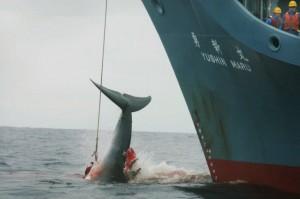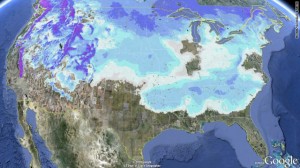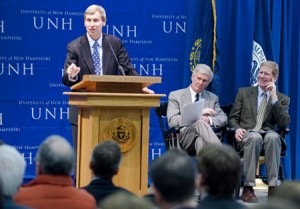Or so it seems. As the planet heats up, global media coverage of the climate is down. Journalists published 23,156 climate-related stories in English last year, down 30 percent from 2009’s count, according to DailyClimate.org.
The new UN climate agreement in Cancun was largely ignored, at least compared with the 2009 edition in Copenhagen. That ‘s the one that brought us the Climategate scandal, which set carbon consciousness back decades. Daily Climate says the December 2010 Cancun conference got a mere 10 seconds of airtime on the major network news.
‘s the one that brought us the Climategate scandal, which set carbon consciousness back decades. Daily Climate says the December 2010 Cancun conference got a mere 10 seconds of airtime on the major network news.
The public just doesn’t seem to care like it used to. Or is it the media?
One thing stifling effective climate coverage is newsroom “tyrannies,” including those of limited time and space, of balance, and of the required “peg” or hook to justify a story’s urgency, says New York Times Dot Earth blogger Andrew Revkin.
‘Bo-ho-ho-ring’
There’s another tyranny, adds a Dot Earth commenter: The Tyranny of Boredom. “What about the simple fact that climate is quite possibly the most boring subject the science world has ever had to present to the public?” Randy Olson asks. “This stuff is bo-ho-ho-ring.”
If boring, it’s also complex. Consider the fact that December 2010 was the United Kingdom’s coldest since nationwide records began in 1910, and it was central England’s second coldest December since 1659. Now that’s a news hook. But being of the man-bites-dog variety, it muddies the waters, undermining the general understanding that global temperatures are, in fact, trending up.
(Eco-jargon compounds the boredom, complexity and confusion. Sustainability, for example,is one of Advertising Age‘s top 10 “jargoniest” pieces of jargon in 2010. “The term is a good concept gone bad by mis- and overuse. It’s come to be a squishy, feel-good catchall for doing the right thing.”)
In all of these cases, the “right” side of the argument is simply drowned out. A wind power company in the UK notes that 66 percent of survey respondents living near its controversial project actually support its proposed massive turbines while only 12 percent oppose them. But you’d never know it. Said the wind power company’s CEO, “We see this too often, the small loud minority being mistaken for the voice of the people.” (via Treehugger)
A new communications weapon
 Concerned climate environmentalists and scientists are hoping to penetrate the ennui and reignite passion for their cause through “mind bombs,” writes Der Spiegel’s Axel Bjanowski. Mind bombs distill a cause into a highly emotional image, such as Greenpeace’s famous bleeding whale (image above), and drive a core message home. But photos of polar bears on ice, violent storms, turbines, or hockey stick graphs have been mind duds. They just aren’t working.
Concerned climate environmentalists and scientists are hoping to penetrate the ennui and reignite passion for their cause through “mind bombs,” writes Der Spiegel’s Axel Bjanowski. Mind bombs distill a cause into a highly emotional image, such as Greenpeace’s famous bleeding whale (image above), and drive a core message home. But photos of polar bears on ice, violent storms, turbines, or hockey stick graphs have been mind duds. They just aren’t working.
Other new communications strategies might include:
Sexy ads, e.g., a good-looking researcher in a bathing suit in the Arctic
- Enlisting scientists to do their own journalism
- Thinking smaller, i.e., focusing on a single, discrete facet of the climate problem and engaging a target audience to act
- Anointing a new Al Gore
- Establishing dedicated channels and processes for communicating important climate findings. (via Der Spiegel)
 My hunch is that climate interest will largely hinge on the mind bombs. Two sets of birds falling from the sky – sad but not climate-related – are insignificant in the great scheme of things, but they generated massive interest this week. Meanwhile, a truly nuclear mind bomb, the BP spill, has an astonishingly short half-life in the public consciousness.
My hunch is that climate interest will largely hinge on the mind bombs. Two sets of birds falling from the sky – sad but not climate-related – are insignificant in the great scheme of things, but they generated massive interest this week. Meanwhile, a truly nuclear mind bomb, the BP spill, has an astonishingly short half-life in the public consciousness.
Climate change is the most important question of our generation: How can we amplify the silent ticking of the most devastating bomb of all, so that we compel the world to disarm it?
 With this in mind, a few recent stories involving Saudi Arabia caught my eye. The first is a pretty straightforward endorsement of the export land model theory. In this story, Abdel Salam al-Yamani, head of the Saudi Electricity Company, is quoted as saying that, if left unchecked, Saudi Arabia’s current domestic oil consumption rates will deplete the country’s reserves by 2030. The second story involves the Saudi’s ramping up a nuclear energy program to the tune of at least $100 billion dollars. This story on the Saudi oil export and energy issue in the Wall Street Journal has a nice graph charting rising Saudi oil consumption. Finally, this story pulls in the previous points and also notes that the Saudi’s are going full bore into an energy source they’re likely to have in abundance for a long time to come: solar. Who knows, maybe one day they’ll be exporting that energy, too. In the meantime, the Middle East, in general, seems interested in conservation to ensure exports of their main revenue source remains high.
With this in mind, a few recent stories involving Saudi Arabia caught my eye. The first is a pretty straightforward endorsement of the export land model theory. In this story, Abdel Salam al-Yamani, head of the Saudi Electricity Company, is quoted as saying that, if left unchecked, Saudi Arabia’s current domestic oil consumption rates will deplete the country’s reserves by 2030. The second story involves the Saudi’s ramping up a nuclear energy program to the tune of at least $100 billion dollars. This story on the Saudi oil export and energy issue in the Wall Street Journal has a nice graph charting rising Saudi oil consumption. Finally, this story pulls in the previous points and also notes that the Saudi’s are going full bore into an energy source they’re likely to have in abundance for a long time to come: solar. Who knows, maybe one day they’ll be exporting that energy, too. In the meantime, the Middle East, in general, seems interested in conservation to ensure exports of their main revenue source remains high.


 (both economically and politically), helping create a higher standard of living, the modern consumer society, and a proliferation of new technologies. Although airplanes and automobiles would continue this revolution, it was the railroad that paved the way.”
(both economically and politically), helping create a higher standard of living, the modern consumer society, and a proliferation of new technologies. Although airplanes and automobiles would continue this revolution, it was the railroad that paved the way.”





